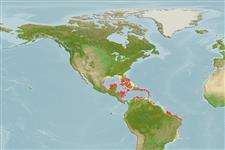>
Kurtiformes (Nurseryfishes, cardinalfishes.) >
Apogonidae (Cardinalfishes) > Apogoninae
Etymology: Astrapogon: Greek, astra = ray + Greek, pogon = chin, beard (Ref. 45335).
More on author: Cope.
Environment: milieu / climate zone / depth range / distribution range
पारिस्थितिकी
समुद्री प्रवाल-भित्ति संयुक्त; गहराई सीमा 1 - 40 m (Ref. 26938). Tropical; 32°N - 24°S
Western Central Atlantic: Bermuda, Florida (USA), and Bahamas to the Antilles (Ref. 26938) and Rio de Janeiro, Brazil (Ref. 57756).
आकार / वज़न / Age
Maturity: Lm ? range ? - ? cm
Max length : 8.0 cm SL पुल्लिंग / अलिंग; (Ref. 26938)
Short description
आकृति विज्ञान | मौरफोमैटरिक्स
Preopercle smooth, scales smooth, no scales on midline in front of dorsal fin.
Prefers clear insular waters of oceanic islands (Ref. 9626). Has a commensal relationship with the conch shell Lobatus gigas (where it is found in the mantle cavity) and with the bivalve Atrina rigida (Ref. 9626). Emerges at night from the conch shell to feed on small crustaceans. Males brood the eggs in their mouths. (Ref. 26938).
Life cycle and mating behavior
परिपक्व अवधि | पुनरुत्पत्ति | मछलीऔ का अंडे देना | अंडे | Fecundity | लार्वा
Are mouthbrooders (Ref. 240, 58876). Distinct pairing during courtship and spawning (Ref. 205).
Robins, C.R. and G.C. Ray, 1986. A field guide to Atlantic coast fishes of North America. Houghton Mifflin Company, Boston, U.S.A. 354 p. (Ref. 7251)
IUCN Red List Status (Ref. 130435)
Threat to humans
Harmless
Human uses
जलजीवालय: व्यापारिक
अधिक जानकारी
संदर्भजलीयकृषिजलीयकृषि रूपरेखाखींचआनुवंशिकीElectrophoresesहैरेटिबिलटीबीमारीप्रक्रमणNutrientsMass conversion
सहयोगीयोतस्वीरेStamps, Coins Misc.ध्वनिसिगुयटिरारफ्तारतैरने के प्रकारगिल क्षेत्रOtolithsदिमागदृष्टि
साधन
Special reports
Download XML
इंटरनेट स्रोत
Estimates based on models
Preferred temperature (Ref.
123201): 24.8 - 28, mean 27.1 °C (based on 188 cells).
Phylogenetic diversity index (Ref.
82804): PD
50 = 0.6250 [Uniqueness, from 0.5 = low to 2.0 = high].
Bayesian length-weight: a=0.01122 (0.00528 - 0.02384), b=3.10 (2.92 - 3.28), in cm total length, based on LWR estimates for this (Sub)family-body shape (Ref.
93245).
Trophic level (Ref.
69278): 3.5 ±0.50 se; based on food items.
लौटाव (Ref.
120179): ऊंचा, न्यूनतम जनसंख्या दुगनी समय अवलागत 15 महीने। (Preliminary K or Fecundity.).
Fishing Vulnerability (Ref.
59153): Low vulnerability (10 of 100).
Nutrients (Ref.
124155): Calcium = 157 [94, 300] mg/100g; Iron = 1.09 [0.64, 1.75] mg/100g; Protein = 18.9 [17.9, 20.0] %; Omega3 = 0.177 [0.105, 0.300] g/100g; Selenium = 30.2 [15.5, 56.9] μg/100g; VitaminA = 99.3 [34.8, 288.1] μg/100g; Zinc = 2.17 [1.45, 3.08] mg/100g (wet weight);
